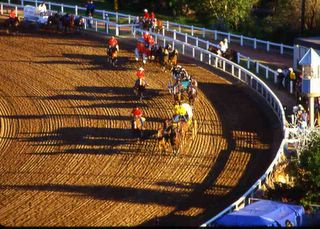
Two Daltons, a Drake, a Travis, a Casey, a Wiley, and a Dustin or two. Names of the cowboys leading the point pack on the afternoon we settled into the grandstand to take in some rodeo at the Calgary Stampede.
“This ain’t no golf game, ladies and gentlemen,” purred the announcer with the deep, gorgeous Calgarian voice as the world’s best cowboys – Albertans, Manitobans, Minnesotans, lots of Texans, a West Virginian, a few Australians – roped cattle with lightning bolt speed and challenged brute force and gravity by staying upright on the thrashing bare backs of unbroken broncos. We thrilled to the action, the raw power of men and animals, the intense display of courage, bravado and physical stamina.
But my favorite part of The Greatest Outdoor Show on Earth, as the Stampede bills itself, was the Chuckwagon Races, “the chucks,” to devotees. Thirty-six men in nine four-crew heats race chuckwagons around the 5/8-mile dirt oval that rims the rodeo infield, enter the infield, navigate a figure-eight around barrels, hurl items representing camp stoves and cooking implements, then bolt back onto the track for the gonzo break to the finish line. Four horses haul each wagon, and each team has a chuck driver and outriders, men who start the race on foot, then mount their horses and try to catch their wagons. Teams lose points if the outriders finish greater than 150 feet behind their chucks.
We had the good fortune to sit next to Jennifer and Kathy, native Calgarians and Chuckwagon groupies. “Haven’t missed a Stampede since we were three years old,” said Jennifer. As the horses, chuck drivers and outriders roared around the golden oval, raked smooth after each heat by smiling, big-paunched guys on green John Deere tractors, Jennifer and Kathy explained every detail, tradition and nuance of this rolling, thundering, galloping spectacle.
They knew the names of every team and every rider and driver, and they pointed out the chucks raced by cowboy families, with fathers, brothers, cousins and uncles dedicated to hurtling a particular wagon through the course and to the finish. Jennifer said many of these men, horses and wagons would be hightailing it down to Cheyenne, Wyoming as soon as the race we were watching was over. These serious rodeo men follow the “chuck circuit” all over North America in pursuit of event purses as large as $50,000. That year, the Cheyenne chucks, a circuit biggie and until recently a major part of Cheyenne Frontier Days, coincided with the Calgary Stampede’s 10 days of eventing. Serious contenders hopped between the two. If a team made the Calgary finals, they’d compete in Wyoming, “then hop a plane in Cheyenne and fly back in time to compete on the last night of the Stampede,” said Jennifer.
Stampede is in Calgarians’ blood. They love it, savor it, are proud of it, set their calendars by it, and never miss it. Cowgirls in full regalia greet tourists at the airport not with, “Welcome to Calgary,” but “Welcome to Stampede.” Then they “brand” you, stick Stampede buttons on your kids’ shirts and whisk you into the main terminal, a space decorated with hay bales and stuffed cowboy figures wearing Levi’s, boots, Stetsons, red bandanas and pearl button shirts. During Stampede, folks gather in parking lots, plazas and in front of strip malls across the city and enjoy carbs and camaraderie at Stampede pancake breakfasts.
During Stampede, nobody says, “Have a nice day,” Have a good evening” or “Take care.” Everybody, Jennifer and Kathy included, wishes everybody else well with a warm, genuine Alberta grin and “Have a good Stampede.”
